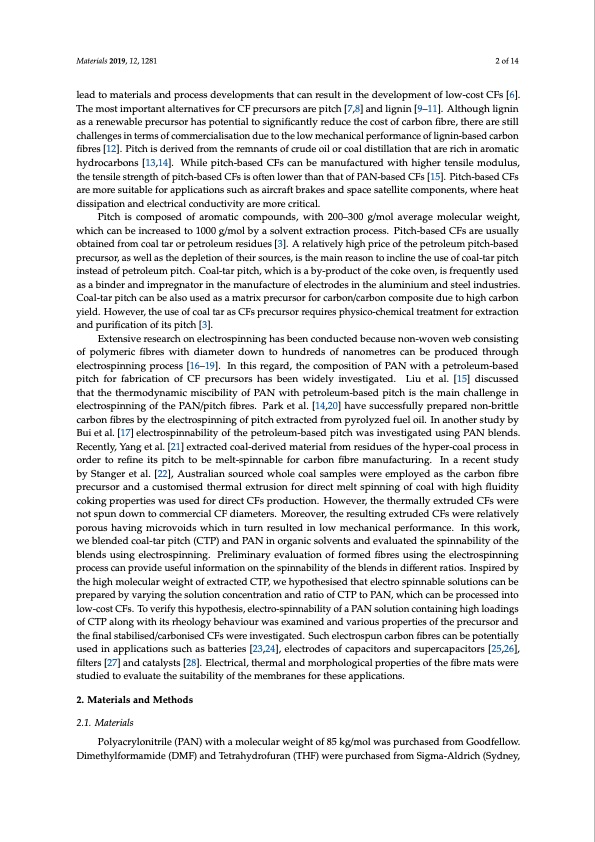
PDF Publication Title:
Text from PDF Page: 002
Materials 2019, 12, 1281 2 of 14 lead to materials and process developments that can result in the development of low-cost CFs [6]. The most important alternatives for CF precursors are pitch [7,8] and lignin [9–11]. Although lignin as a renewable precursor has potential to significantly reduce the cost of carbon fibre, there are still challenges in terms of commercialisation due to the low mechanical performance of lignin-based carbon fibres [12]. Pitch is derived from the remnants of crude oil or coal distillation that are rich in aromatic hydrocarbons [13,14]. While pitch-based CFs can be manufactured with higher tensile modulus, the tensile strength of pitch-based CFs is often lower than that of PAN-based CFs [15]. Pitch-based CFs are more suitable for applications such as aircraft brakes and space satellite components, where heat dissipation and electrical conductivity are more critical. Pitch is composed of aromatic compounds, with 200–300 g/mol average molecular weight, which can be increased to 1000 g/mol by a solvent extraction process. Pitch-based CFs are usually obtained from coal tar or petroleum residues [3]. A relatively high price of the petroleum pitch-based precursor, as well as the depletion of their sources, is the main reason to incline the use of coal-tar pitch instead of petroleum pitch. Coal-tar pitch, which is a by-product of the coke oven, is frequently used as a binder and impregnator in the manufacture of electrodes in the aluminium and steel industries. Coal-tar pitch can be also used as a matrix precursor for carbon/carbon composite due to high carbon yield. However, the use of coal tar as CFs precursor requires physico-chemical treatment for extraction and purification of its pitch [3]. Extensive research on electrospinning has been conducted because non-woven web consisting of polymeric fibres with diameter down to hundreds of nanometres can be produced through electrospinning process [16–19]. In this regard, the composition of PAN with a petroleum-based pitch for fabrication of CF precursors has been widely investigated. Liu et al. [15] discussed that the thermodynamic miscibility of PAN with petroleum-based pitch is the main challenge in electrospinning of the PAN/pitch fibres. Park et al. [14,20] have successfully prepared non-brittle carbon fibres by the electrospinning of pitch extracted from pyrolyzed fuel oil. In another study by Bui et al. [17] electrospinnability of the petroleum-based pitch was investigated using PAN blends. Recently, Yang et al. [21] extracted coal-derived material from residues of the hyper-coal process in order to refine its pitch to be melt-spinnable for carbon fibre manufacturing. In a recent study by Stanger et al. [22], Australian sourced whole coal samples were employed as the carbon fibre precursor and a customised thermal extrusion for direct melt spinning of coal with high fluidity coking properties was used for direct CFs production. However, the thermally extruded CFs were not spun down to commercial CF diameters. Moreover, the resulting extruded CFs were relatively porous having microvoids which in turn resulted in low mechanical performance. In this work, we blended coal-tar pitch (CTP) and PAN in organic solvents and evaluated the spinnability of the blends using electrospinning. Preliminary evaluation of formed fibres using the electrospinning process can provide useful information on the spinnability of the blends in different ratios. Inspired by the high molecular weight of extracted CTP, we hypothesised that electro spinnable solutions can be prepared by varying the solution concentration and ratio of CTP to PAN, which can be processed into low-cost CFs. To verify this hypothesis, electro-spinnability of a PAN solution containing high loadings of CTP along with its rheology behaviour was examined and various properties of the precursor and the final stabilised/carbonised CFs were investigated. Such electrospun carbon fibres can be potentially used in applications such as batteries [23,24], electrodes of capacitors and supercapacitors [25,26], filters [27] and catalysts [28]. Electrical, thermal and morphological properties of the fibre mats were studied to evaluate the suitability of the membranes for these applications. 2. Materials and Methods 2.1. Materials Polyacrylonitrile (PAN) with a molecular weight of 85 kg/mol was purchased from Goodfellow. Dimethylformamide (DMF) and Tetrahydrofuran (THF) were purchased from Sigma-Aldrich (Sydney,PDF Image | Low-Cost Carbon Fibre Derived from Sustainable Coal Tar Pitch and Polyacrylonitrile

PDF Search Title:
Low-Cost Carbon Fibre Derived from Sustainable Coal Tar Pitch and PolyacrylonitrileOriginal File Name Searched:
6e63fb65b81e089e97ddfbe19bee7d22311e.pdfDIY PDF Search: Google It | Yahoo | Bing
Sulfur Deposition on Carbon Nanofibers using Supercritical CO2 Sulfur Deposition on Carbon Nanofibers using Supercritical CO2. Gamma sulfur also known as mother of pearl sulfur and nacreous sulfur... More Info
CO2 Organic Rankine Cycle Experimenter Platform The supercritical CO2 phase change system is both a heat pump and organic rankine cycle which can be used for those purposes and as a supercritical extractor for advanced subcritical and supercritical extraction technology. Uses include producing nanoparticles, precious metal CO2 extraction, lithium battery recycling, and other applications... More Info
| CONTACT TEL: 608-238-6001 Email: greg@infinityturbine.com | RSS | AMP |